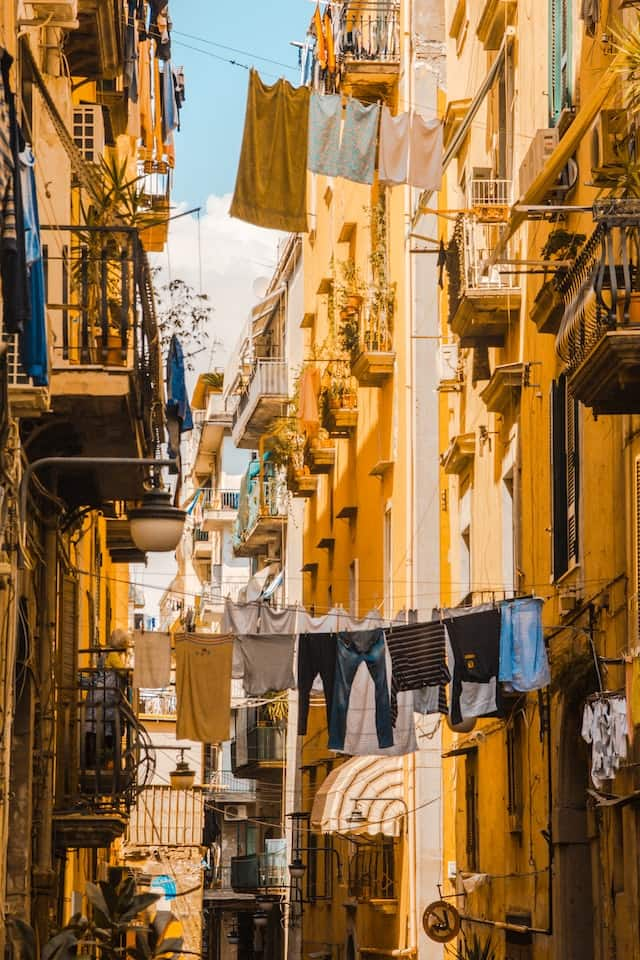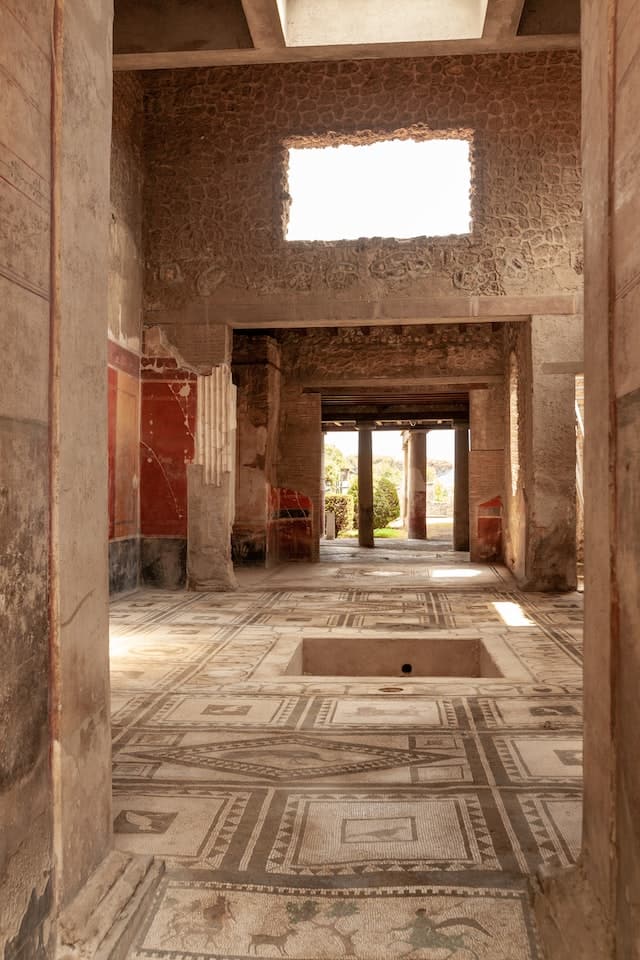Mount Vesuvius at sunrise, overlooking Napoli. (Photo: Judi Smith via Unsplash)
I visited Naples in late 2021. It was my first trip as a tourist post-COVID. Although only a two-hour flight from Madrid, where I live, it felt like a continent away – or more specifically like a certain subcontinent that many of you, gentle readers, are familiar with.
The friends we were staying with described the city as “Calcutta with baroque”, and so it was. Although there was something of other Indian cities in it too. Its tenements called to mind the chawls of Bombay and the peeling edifices of its grander homes, the crumbling havelis of Delhi. In the energy and crush of its streets, jampacked with fruit sellers, carelessly discarded garbage and hollering neighbours, there were echoes of small-town India.
 A lane in Naples, Italy, has echoes of many Indian cities. (Photo: Samuel C via Unsplash)
A lane in Naples, Italy, has echoes of many Indian cities. (Photo: Samuel C via Unsplash)
What hit me first was the familiar (to an Indian) aural eclecticism of car horns and squealing toddlers. And the simultaneity of disjunctive temporality – the medieval and modern.
Hanging over it all was the salt of the sea air, whispering a dream of open spaces that shimmered just around the corner, but that to many inhabitants in the poorer parts of the city’s interior, might as well have been in Timbuktu.
Before having set foot in the city, I had already inhabited Naples for many years, as I’d read my way through Elena Ferrante’s Neapolitan Quartet – a tale of female friendship with all its sharp edges, but also a story of the city of Naples.

Ferrante’s words dogged me as I walked – as one must when in Naples, for it is only by foot that much of the city can be accessed and assessed. “There is no decipherable order,” Ferrante had written of it. “Just an unruly and irrepressible crowd in the streets cluttered with vendors of every possible merchandise, people talking very loudly, urchins, beggars. Ah, there is no city that spreads so much noise and noise as Naples.”
I remember thinking Ferrante was obviously innocent of any Indian city, even though she was writing in many ways, the story of every Indian city. Consider this quote from the first novel in the quartet:
“In what disorder we lived, how many fragments of ourselves were scattered, as if to live were to explode into splinters.”
***
But this most Asian of European cities is also a microcosm of the gamut of European history, a journey that is inscribed upon its palimpsest-body. There are traces of Naples’s Greek origins, on which lie the ruins of its long-Roman avatar, atop which are strewn the piazzas, palaces and churches of the Normans (French), Swabians (Teutons/Germans), Anjous (also French – late 13th to mid 15th century) and Aragonese (Spain, from the early 16th century for 200-odd years). Then the Spanish-Bourbons (French-Spanish) were back for about a century. Following a few further twists in its fortunes, the city was unified with the rest of Italy in 1861.
To the non-European history aficionado, and I suspect to the working-class Neapolitans described in Ferrante novels as well, this is all quite confusing. Suffice to say that for hundreds of years Naples was ruled by peoples – mainly from modern-day France and Spain (though they were known by names like Normans and Bourbons and Aragonese and Hapsburgs) by rulers called Charles, Louis, Alfonso, Ferdinand and so on.
The import for the modern traveller is that walking the streets of Naples is like taking a master class in European art and architecture – through the Romanesque, the gothic, the classical, the baroque (which dominates), to the neo-classical and modern, all framed by drying laundry, punctuated by the aroma of pizza and watched over by the brooding bulk of Mt Vesuvius.
 (Photo: Luigi Boccardo via Unsplash)
(Photo: Luigi Boccardo via Unsplash)
***
Highlights for me included the frescos that adorn the interior walls of the cloister of the basilica of Santa Chiara in a carpet of gold and pastel Franciscan tales. They whisper, “Italy” with a reasonably restrained exclamation mark. The walkways that divide the central garden of lavender and citrus trees are lined with painted ceramic-tiles. Lovely!
For all the baroque you will ever need, there is the church of Gesu Nuovo, right opposite Santa Chiara. Its shell is a stern-stone Giuseppe Valeriani–designed façade that leads into impressive opulence. Marble, frescoes, vaulted ceilings and gilt, razzle and dazzle the beholder. It’s enough to give the Sistine chapel a bout of FOMO.
When we visited, a mass was underway with a priest preaching to a congregation made up entirely of Sri Lankan immigrants, in Sinhala.
 (Photo by Lory P via Unsplash)
(Photo by Lory P via Unsplash)
***
But my younger son, Nico, was unimpressed. He wanted to see something “really old”. No medieval malarkey for him. He craved antiquity, and so we headed down. Naples, you see, exists on many levels, and this is not just metaphorical.
Under the city’s surface clamour, there is a silent world that speaks of 2,400 years of history in the voice of Greek agoras, Roman aqueducts, Christian burial grounds and World War II bomb shelters. It’s an Alice in Wonderland reality. Any opening in the floor of a building – palace or hovel – can plunge you into another time; the lower you descend, the further back you travel.
We chose our submersion at the San Lorenzo Maggiore, a basilica dating to 1270, 10 meters below which a labyrinth of Roman baths, fabric dying workshops, stores and water tanks, whetted our appetite for the highlight of the trip: Herculaneum, aka Pompeii for the discerning.
 Pompei, Metropolitan City of Naples, Italy (Photo: Yaopey Yong via Unsplash)
Pompei, Metropolitan City of Naples, Italy (Photo: Yaopey Yong via Unsplash)
***
Smaller, better preserved and closer to Naples than its tourist-infested counterpart, Pompeii, Herculaneum was also destroyed in the 79 AD eruption of the mercurial mount of Vesuvius.
There was a partial train strike on the day of our visit – one more Calcutta-like feature of Naples – so that the ride to the site had us feeling somewhat sardine-ish. But before long we had shaken off all fishiness and were pleased to discover that most of our fellow train passengers had continued on to Pompeii, leaving Herculaneum serene in the late afternoon sun.
The particular circumstances of the burial of Herculaneum had led to the city being wrapped in a compact mass of tufaceous material, about 60 feet (18 meters) deep. (OK, this sentence is pretty much lifted from the Encyclopedia Britanica, and I had to google “tufaceous.” It’s: “soft, friable, and porous sedimentary rock consisting of calcium carbonate and formed by the evaporation of water.”)
This made excavations tough, but prevented tampering and looting, so that when the city was finally unearthed, it was mind-bogglingly intact. The ground humidity had facilitated the conservation of the wooden frameworks of houses, wooden furniture, pieces of cloth, and even food. Carbonized loaves of bread had been left – and were found- within ovens!
Our guide, a charming young woman, kept talking about how the intense heat generated by the pyroclastic flows (more googling was needed and yielded: “a dense, fast-moving flow of solidified lava pieces, volcanic ash, and hot gases) meant that thousands of papyrus scrolls had been “char-ed.” Unlike how it sounds, this was actually a good thing.
Because of the high temperature and lack of oxygen, said scrolls were carbonization into compact blocks that were then preserved by the layers of cement-like rock above, giving the world access to 2,000-year-old texts. (If you are excited by this sort of thing, do read this piece in the Smithsonian magazine, “Buried by the Ash of Vesuvius, These Scrolls Are Being Read for the First Time in Millennia”.)
***
Our trip to Naples was four days long but packed in a month’s-worth of calories. It involved a lot of pizza and gelato. I have no regrets.
What I do need is to get hold of my Ferrante books and re-read them, but they seem to have evaporated – probably the effect of the pyroclastic flows of the metaphorical volcanic eruption that is moving countries. Hopefully they’ll reappear, uncarbonized, at some point, so I can be with Lina and Lenu as they make their way through Napoli, once again. And this time wiser in the ways of their city.
Source: https://news.google.com/__i/rss/rd/articles/CBMifmh0dHBzOi8vd3d3Lm1vbmV5Y29udHJvbC5jb20vbmV3cy90cmVuZHMvdHJhdmVsLXRyZW5kcy9ob3ctdG8tZGVzY3JpYmUtbmFwbGVzLWl0YWx5LWl0cy1jYWxjdXR0YS1idXQtbW9yZS1iYXJvcXVlLTk4MjU3MjEuaHRtbNIBggFodHRwczovL3d3dy5tb25leWNvbnRyb2wuY29tL25ld3MvdHJlbmRzL3RyYXZlbC10cmVuZHMvaG93LXRvLWRlc2NyaWJlLW5hcGxlcy1pdGFseS1pdHMtY2FsY3V0dGEtYnV0LW1vcmUtYmFyb3F1ZS05ODI1NzIxLmh0bWwvYW1w?oc=5

